IMPROVE YOUR CHILD FITNESS THROUGHT YOGA
IMPROVE YOUR CHILD FITNESS
Yoga (meaning union or yoke) is the practice of accessing and integrating all aspects of our true nature — body, mind, and spirit — in the pursuit of inner harmony. As yoga becomes more popular in schools through physical education classes and after-school programs, that popularity comes with controversy. Although many adults like the benefits of yoga, some parents feel that the practice might have a religious association and, like prayer, shouldn’t be allowed in a public space. They argue that yoga is an offshoot of Hinduism and that it disseminates religious and meditation principles with its use of “om” and “namaste” chanting. Some also believe that the asanas, or postures, such as the sun salutation, are a form of Hindu religious worship. To dispel this notion and avoid any religious or cultural messages, most yoga teachers focus on the benefits of the exercises and use generic terms, instead of the Sanskrit names, for the poses, renaming them cat, bridge, table, tree, downward-facing dog, volcano, and so forth. Yoga’s rising popularity can be attributed to its basic stretching advantages and improved body awareness, with the added component of a mind-body connection.
Despite the controversy, yoga is beneficial to kids in many ways. Because children encounter emotional, social, and physical challenges or conflicts, a dedicated and intentional yoga practice that includes breathing techniques, behavioral guidelines, and physical postures can be incredibly valuable for them, yoga is something children can practice anywhere and that the breathing, the concentration, the poses, and the way kids learn to act or react to situations, will lead to constant self-discovery and inquisitiveness. Plus, yoga is portable, and no mat, special clothing, or special pillow is absolutely necessary.
Yoga builds self-esteem and self-respect. “A child’s yoga practice is a rare opportunity to experience play and focus without worrying about being wrong,” yoga is an option for children who shy away from physical activity or group activities for fear of failure or being picked last, and it helps athletic children excel in other physical activities and sports. yoga introduces cornerstone values “such as non-harming, truthfulness, moderation, cleanliness, gratitude, and self-discipline.’’
There are five key areas where kids benefit from the practice of yoga, and each of them improves their overall well-being.
It Enhances Physical Flexibility
Yoga promotes physical strength because kids learn to use all of their muscles in new ways. Whether a pose is done standing, sitting, or lying down, each one can challenge various muscle groups while helping a child become aware of his body and how it efficiently functions.
It Refines Balance and Coordination
Balance is a key element of yoga. Balancing poses were created to promote mental and physical poise, as mental clarity and stability emerge from the effort of trying the poses. Even if a child has difficulty standing on one foot, she learns mental and physical balance if she can stay calm when she falls and when she gets up to try again. As children learn to improve their physical balance, they will be filled with a sense of accomplishment. Coordination is also closely tied to balance and promotes overall dexterity. Some yoga teachers and occupational therapists use finger yoga and other specialized techniques to help children with gross and fine motor coordination.
It Develops Focus and Concentration
The act of practicing poses encourages children to clear their mind and focus on the effort. As a result of this single focus to achieve a particular pose or stay balanced, yoga helps children to focus and concentrate in school and get better grades, several studies note.
It Boosts Self-Esteem and Confidence
Yoga helps to instill confidence and to bring learning to children on an experiential level. It also helps to provide building blocks for the future. It is our responsibility to develop our children’s sense of wonder and to give them a strong sense of self so they know where they belong in this world and can contribute to making their community a better place.” Yoga teaches them to persevere, be patient, and work toward their goals. A yoga teacher can only offer guidance; it is the child who has to work to succeed. Therefore, when a child masters a pose, it gives him confidence and self-esteem and goal oriented. Kids’ yoga as “prehabilitation,” a proactive action to ward off instability or sickness; yoga also provides tools for practicing compassion, mindfulness, generosity, focus, strength, and flexibility.
It Strengthens the Mind-Body Connection
Yoga helps kids achieve a sound mind in a sound body by exercising the physical body and calming the mental spirit. “As parents we want our children to act and behave with mindfulness and with compassion, to be brave, to know love and happiness, and to find inner peace. Moreover since the modern world moves very, very fast for children, it’s not long before they feel all kinds of pressure (personal, parental, social) to keep up with everyone around them. Yoga functions as a release valve that alleviates pressure and as a foundation to nurture and develop a resilient and resourceful body, mind, and spirit.
Yoga is beneficial to children of all ages, but it has been found to be particularly so for kids with special needs. Studies have shown that yoga benefits children with autism and ADHD. Many articles has reported that yoga program and found that the program reduced kids’ aggressive behavior, social withdrawal, and hyperactivity, compared with a control group of kids with autism who did not practice yoga. Yoga is effective because it seemed to play to the strengths of kids with autism while also reducing stress. Autism Key, an autism support website, says that yoga helps address kids’ heightened anxiety, poor motor coordination, and weak self-regulation, something that otherwise is very difficult to do.
Parents may notice how yoga benefits their kids, but the best judges are the kids themselves. Children who have practiced yoga tell teachers and parents that they are able to concentrate better during the day, focus better on their activities, and pay attention to their tasks — all the finest endorsements.
Listed below are some easy yoga poses that you can follow
Happy Baby Pose: This pose helps to pacify the mind and body relieving stress and fatigue. It gently stretches the inner groins and spine. Ask the child to gently rock side to side.
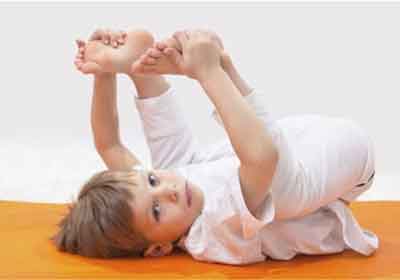
Snake Pose: It strengthens the spine, backs of arms and legs and also stretches the shoulders, chest, and belly. To encourage breathing, have kids hiss like a snake.
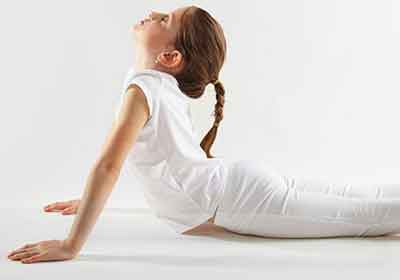
Butterfly Pose: Get ready for a good night’s sleep! This pose helps calm the body and mind, helps relieve stress and fatigue. It’s great for opening the hips and a good stretch for the ankles.
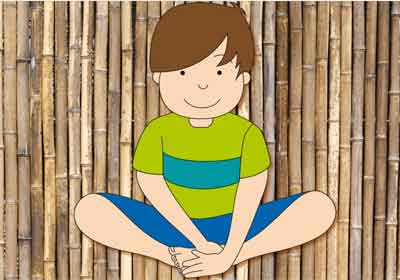
Tree Pose:
This pose improves balance, strengthens the thighs, calves and ankles, stretches legs and even develops concentration.
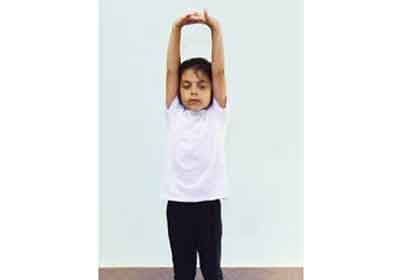
Setu Bandha Sarvangasana (Bridge) –
For this position, have your child lie on his back. Make him bend both knees in a way the feet would be flat on the ground. Once this is done, have him bring the heels as close to his bottom as possible and as much as he comfortably can. Then, ask him to lift his hips high. Most kids have a flexible spine, so they can press their hips up very high. This pose is great for leg strength, ankle stability, and energy.
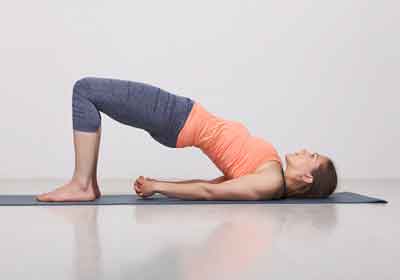
Navasana (Partner Boat Pose/Double Boat Pose)
This one is a partner pose. First- ask both of them to sit down facing each other. Then tell both of them to raise their legs slightly upwards and join their toes with their partner’s toes. Now, they need to raise and hold each other’s hands. They need to use some pressure and push the partner’s soles. Ask them to breathe normally and return to the original state by first putting their feet down slowly and then, releasing their hands. I am sure your kids will love this one. Moreover, it a great stress buster too! Some of its benefits include improvement in the digestive system, strengthening of the backbone. Not to mention, it helps the children learn teamwork.
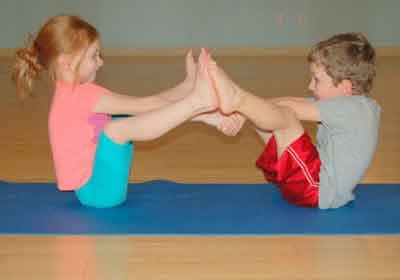
Vriksasana
Ask them to Inhale and stand erect. Then tell them to put their left sole a little bit upwards, but their toe should be on the floor. Your left sole should be on the floor and touch your right toe. To balance yourself, extend your hands upwards. Your right leg should be straight and the right knee should be locked. Look upwards and breathe normally. Stay in this position for 5-7 seconds. Repeat this pose with the other leg. This pose helps to balance your body and stretches the chest. It will strengthen your child’s legs and hands too.
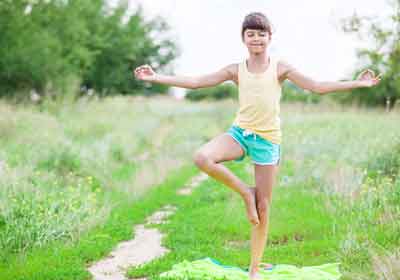
Dekasana (Airplane Pose)
Have him breathe in and stand straight. Make him put his right leg forward. Both his knees should be straight and locked and also needs to lean his body a little forward. Ask him to raise his arms upwards on either side to maintain the balance. The thing to keep in mind is that his body pose should be like a flying airplane. He should stay in this posture for a few seconds. Some benefits of this yoga are that it helps to increase the concentration level and also teaches kids to maintain balance. It even strengthens the legs, chest, and hands.
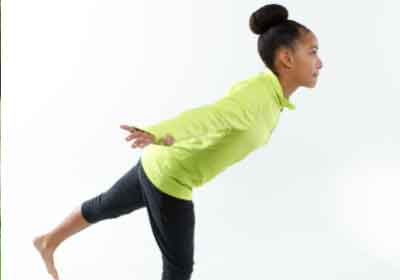
Anjali Mudra (Salutation Seal)
He should begin by breathing in and sitting down and crossing his legs. Encourage him/her hold both palms together, in a ‘Namaste’ pose, while asking him to inhale. His back should be straight. He should stay in this position for 1 minute or so and breathe normally, then deeply. This yoga pose works as a great stress-buster, which will ultimately relax his body and provide him peace of mind.
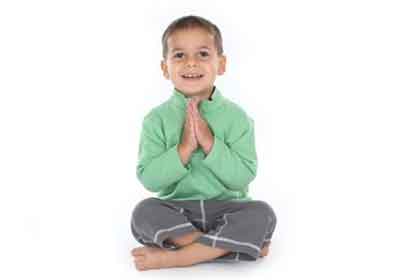
Tadasana (Mountain Pose)
Have him stand straight. Tell him to take a deep breath while also keeping his spinal cord straight. His legs should be straight and knees, locked. Both his toes should touch each other and the hands need to be downwards and straight. Staying in this position for 30 seconds or so, make him inhale and exhale deeply. Some benefits of this pose are that it helps to improve body posture and even strengthens the legs and muscles.
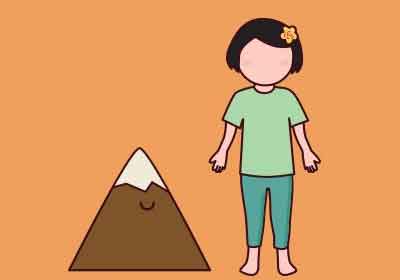
Benefits of yoga in children
We all know how competitive today’s world has become and this has put a lot of burden and stress even on children and teenagers. They are loaded with heavy books to make their future bright. There’s hardly any time for extracurricular activities and to add to that there’s the consumption of all that unhealthy junk food too. Under such a situation, the most excellent way to keep your little one healthy and hearty is yoga.
Yoga helps to improve concentration, boosts confidence, and reduces the level of stress too. Hence, introducing your children to yoga at an early age can help them learn healthy lifestyle habits and set the foundation for a fit future. I hope this article will help you achieve that! Stay healthy, stay happy!
- Makes them physically alert and fit.
- Helps in defining a better posture in children.
- Besides these eye yoga exercises are beneficial in improving vision and has widely gained popularity in recent times where our eye sight starts becoming weaker since an earlier age due to increased computer usage and other screen timings.
- Yoga also helps in digital detox, reducing digital obsession, improving imagination and creativity. Secondly, they calm the nervous system and increase patience, self-awareness, confidence and help overcome stage fright.
- Along with yoga asanas, meditation even for a short span of time helps to make them calm and form a deeper understanding of self. Thus keeping their body as well as their mind fit.
- Builds up the body and keeps one healthy by improving digestion which ultimately improves immunity and strength.
- Helps improve posture alignment as children are constantly on laptops or reading books which pressurizes their neck and back.
- Body, limbs and mind get disciplined and channelled to function in the right way.
- Helps in improving strength, flexibility and endurance.
- Makes one feel energetic and improves vision.
- Cleanses and purifies the body and the mind.
- Increases concentration levels and sharpens memory.
- Brings clarity in speech, thoughts and expression.
- Creates calmness and brings stability in thoughts.
- Last but not least, yoga teaches children to love and embrace themselves, fostering their self-esteem.
INCREASE YOUR CHILDS FITNESS THROUGHT YOGA BY BEST YOGA TRAINER IN DHAKOLI
An experienced and pediatric expert yoga trainer can help your child to enhance his/her physical health. There are few trainers who understand the exact psychology of kids and give them training accordingly in a very calm manner. Dr.Jyoti Gupta is one of such instructor she is a knowledgeable and experience to deal in kids because she is Pediatrics Physiotherapist as well as a certified Yoga instructor she complete her course from a well known YOGA ALLIANCE INTER NATIONAL FnY STUDIO. So she always applies her valuable skill from the root of the cause and focus on positive outcome.
With Dr Jyoti Gupta in Blossom physiotherapy center there are teams of various staff and assistants work together on child and always come with visible results. The noticeable outcome results make Blossom physiotherapy center different in Dhakoli . They also provide friendly atmosphere for the child and parents with the help of that the child become more innovative. And various skill activities and yoga poses performed by kid make his/her body fit and strong. Moreover yoga enhances immunity of kid with the help of that child become strong internally. Yoga additionally enhances behavior of the child and help in make child intelligent and more productive. So in nutshell Blossom physiotherapy is prepared to help you in every manner in this pandemic with full of precautions. So I must say that you have to once visit in the clinic you will defiantly attached with the staff and atmosphere of clinic and love them. For further information log into https:/www.blossomphysitherapy.in



